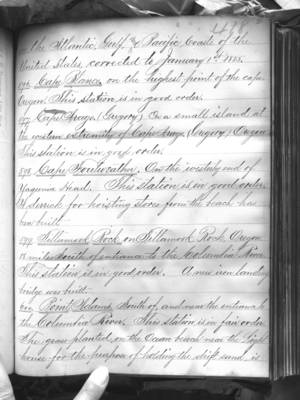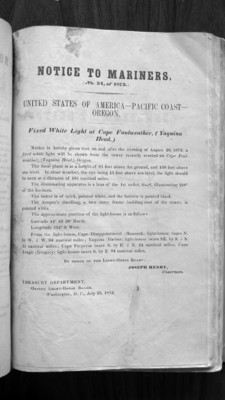Pages That Mention Cape Arago
Vol 631 Tramway Winch LH Reports 1884 and 1885
21
on the Atlantic, Gulf, and Pacific Coasts of the United States, corrected to January 1st 1885.
596 Cape Blanco on the highest point of the cape, Oregon. This station is in good order. 597. Cape Arago. (Gregory) On a small island at the western extremity of Cape Arago. (Gregory) Oregon This Station is in good order. 598. Cape Foulweather. On the westerly end of Yaquina Head. This station is in good order. A derrick for hoisting stores from the beach has been built. 599. Tillamook Rock on Tillamook Rock, Oregon. 18 miles South of entrance to the Columbia River. This station is in good order. A new iron landing bridge was built. 600. Point Adams. South of, and near the entrance to the Columbia River. This station is in fair order. The grass planted on the ocean beach near the Lighthouse for the purpose of holding the drift sand, is
1871-1872 keeper selection and LH building Vol. 336
23
From the light house
Cape Disappointment (Hancock) Lighthouse Bears N by W 3/4 W 95 Nautical Miles
Yaquina Harbor Light-house Bears SE by S 1/2S
Cape Perpetua Bears S by E 3/4 E 21 Nautical Miles
Cape Arago (Gregory) Lighthose Bears S by E 84 Nautical Miles
p-2 Notice To Mariners
3
Notice to Mariners No. 34, of 1873
United States of America - Pacific Coast - Oregon
Fixed White Light at Cape Foulweather, (Yaquina Head)
Notice is hereby given that, on and after the evening of August 20, 1873, a fixed white light will be shown from the tower recently erected on Cape Foulweather, (Yaquina Head,) Oregon.
The focal plane is at a height of 81 feet above the ground and 150 feet above sea level. In clear weather, the eye being 15 feet above sea level, the light should be seen at a distance of 18 1/2 nautical miles.
The illuminating apparatus is a lens of the 1st order, fixed, illuminating 240 degrees of the horizon.
The tower is of brick, painted white, and the lantern is painted black.
The keeper's dwelling, a two story frame building east of the tower, is painted white.
The approximate position of the light-house is as follows:
Latitude 44 degrees 43' 30" North Longitude 124 degrees 5' West
From the light-house, Cape Disappointment (Hancock) light-house bears N. by W. 3/4 W. 94 nautical miles; Yaquina (Harbor) light-house bears S.E. by S. 1/4 S. 3 1/4 nautical miles; Cape Perpetua bears S. by E. 3/4 E. 24 nautical miles; Cape Arago (Gregory) light-house bears S. by E. 84 nautical miles.
By order of the Light-House Board:
Joseph Henry, Chairman
Treasury Department Office Light-House board, Washington, D.C., July 25, 1873
Coast Guard District narrative histories 1945
11
labor consumed far too much valuable time, and so it became expedient that there be a swifter method. By 1942, Headquarters developed a radio control system for aids to navigation intended primarily for blacking out unattended lighted aids by means of radio signal. The system was designated by the coined word "RACAN" which was later changed to ANRAC to avoid confusion with RADAR beacons or RACONS.
After a thorough study of the use of ANRAC, the District Coast Guard Officer, 13th Naval District, requested Headquarters' authority to install the equipment with the Cape Disappointment Light Station as the control unit for the radio extinguishing of ten buoys in the lower Columbia River. Because of the delay in the delivery of ANRAC equipment, it was not until March, 1944 that the first two ANRAC equipped buoys were placed on station. All maintenance and repair work for this installation of special buoy equipment was handled at the Tongue Point Repair Base, Tongue Point, Oregon. Later at the request of the Commandant, 13th Naval District, the District Coast Guard Officer requested that ANRAC controlled buoys be placed in the Grays Harbor and Willapa Bay areas. Headquarters authorized these installations, but later experiments with ANRAC did not prove satisfactory and permission was requested of Headquarters to discontinue this type of equipment. This request to remove ANRAC equipment from the Columbia River, Grays Harbor, and Willapa Bay was finally approved.
Early in 1943, the Navy had decided to install RACONS on Coast Guard Light Stations at Cape Arago, Cape Blanco, Heceta Head, and Yaquina Head in Oregon. Sixteen Coast Guardsmen were schooled in the operation and maintenance of RACON equipment at a one week training course at the Naval Air Station, Seattle, a short time before the installations were completed. By the end of May, 1943, RACONS were in operation at the above Coast Guard units as well as at the Port Angeles Air Station and the Cape Flattery Light Station.
At the beginning of 1944, the Chief of Naval Operations directed the transfer of all Navy "pulse" equipment to the Coast Guard for operation and maintenance. The first RACON station to be transferred was the installation at Tillamook Naval Air Station which was assumed by the Coast Guard on 1 May, 1945. The stations at Shelton, Quillayute, Whidby Island, and Seattle in the state of Washington, and Astoria, and Oceanside in Oregon were transferred to the Coast Guard. Other RACON units were established subsequently in the 13th Naval District. At the conclusion of the war, various Auxiliary Stations were discontinued and the RACON stations at each were placed in caretaker status.
-28-
21
In the quite rapid succession, Umpqua River, Willapa Bay, Smith Island, Ediz Hook, Cape Arago, Cape Blanco, Point No Point, Point Wilson, and Yaquina Bay Lighthouses were built. In 1879, construction began on the Tillamook Rock Beacon.
Tillamook Rock Lighthouse was one of the most famous as well as one of the most exposed stations in the Lighthouse Service, set on a great precipitous rock lying a mile offshore from Tillamook Head on the Oregon Coast. A dark cloud of ill omen shadowed the station as, in the landing of the construction party, the superintendent was swept by a great wave into the sea and drowned. Almost insurmountable obstacles faced the engineers, for the entire top of the rock mass had to be blasted level to provide space for the lighthouse and its accompanying structures. Heavy seas continually washed over the Rock carrying away half finished foundations, equipment and endangering the lives of the entire work party. Although the light stood 133 feet above the water, on many occasions tremendous waves swept completely over the station carrying large fragments of rock which caused considerable damage to the station. On one such occasion, a rock weighting 135 pounds was hurled through the roof of the building and into the quarters below, causing extensive damage. Another time, the sea tossed a boulder through the lantern, extinguished the light and flooded the dwelling below.
West Point, built in 1881, Alki Point and Brown Point, built in 1887 and Destruction Island, built in 1891, were the next light stations to be erected. Here again, at Destruction Island, treacherous seas made landings difficult except in calm weather, so the "basket" and boom were again called upon for safe landings on the station. 14 other lighthouses were established in the Seattle District, the last being the Lim Kiln structure in 1914. Strangely enough, the Lime Kiln Lighthouse was the last light station in the District operating an oil lantern. An attempt was made to electrify the light by extending commercial power to the Station but the Power Company was unable to furnish sufficient current; in the same regard, poles had to be set in a solid rock and the cost and labor for this were almost prohibitive. A request was made for Headquarters' approval to install a power plant at the unit but this was not commensurate with Headquarters' policy so the light remained an incandescent oil vapor type. This type, familiarly known as i.o.v., gave good service although its range could not match that of the newer electric light. The old i.o.v. light came in two sizes and was approximately equivalent
-2-




